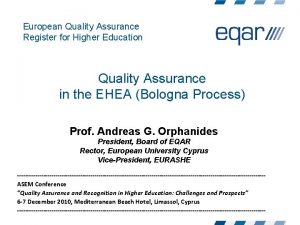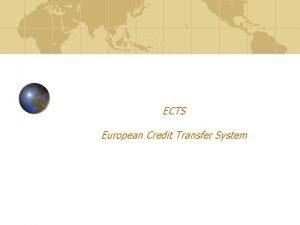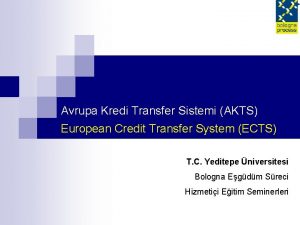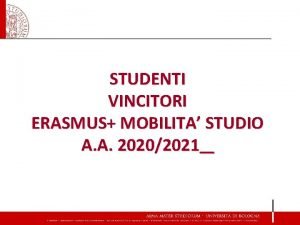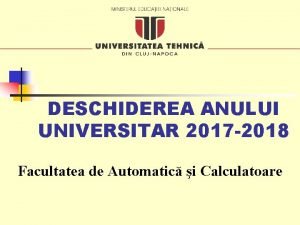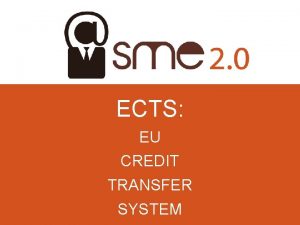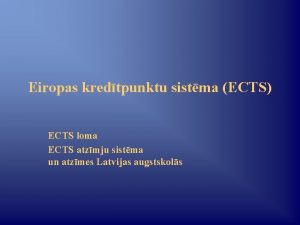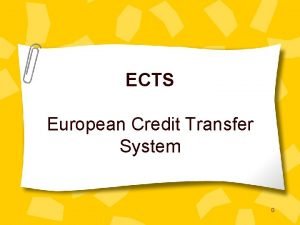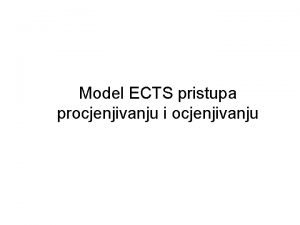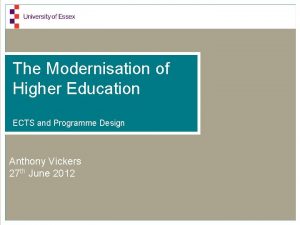ECTS in European higher education the impact of












- Slides: 12

ECTS in European higher education: the impact of Bologna Brussels, 25 February 2013 David Crosier, EURYDICE

Presentation • • Overview Comparison of European mapping of ECTS implementation in Bologna official and stakeholder reports: - Bologna Implementation Report 2012 - EUA Trends 2010 - ESU Bologna with Student Eyes 2012 Common conclusions

Bologna Implementation Report Programmes using ECTS for accumulation and transfer, 2010/11 < 50% 51 – 74% 75 – 99% 100% Data not available

Bologna Implementation Report ECTS linked to Learning Outcomes, 2010/11 No programmes < 5% 5 – 49% 50 – 99% 100% Data not available

Bologna Implementation Report Scorecard indicator: implementation of ECTS system, 2010/11 ECTS for all programmes; transfer/accumulation & LOs ECTS for more than 75% of programmes ECTS for 50 – 75% of programmes ECTS for 49% of programmes or national credit system not fully compatible ECTS in less than 49% of programmes or only used for credit transfer Data not available

EUA Trends 2010 Key Findings • use of ECTS continues to grow: 88% of HEIs using ECTS for credit accumulation in all 1 st and 2 nd cycle programmes (up from 66% in Trends V) 90% of HEIs using ECTS for credit transfer (up from 75% in Trends V) • Doubts over the way in which ECTS is used

EUA Trends 2010: Credit transfer by largest group of respondents

EUA Trends 2010: Credit accumulation by largest group of respondents

BWSE 2012 Key Findings • Use of ECTS high, but some exceptions: while 24 (of 31) student unions report widespread use of ECTS, 5 say that use is low/non existent in 21 systems workload commonly used as a basis for credits In 12 systems, learning outcomes are used

ESU BWSE 2012

ESU BWSE 2012

Common conclusions from the reports: • Use of ECTS has developed to a point where it is unchallenged as the credit system for higher education • The intended purposes of the system are not fully addressed in national/institutional implementation • Learning Outcomes are not yet widely understood & used in programme design, & hence the "ideal approach" of the 2009 User Guide is rarely found in reality 12
 European quality assurance register for higher education
European quality assurance register for higher education What is ects credits
What is ects credits Ects
Ects Avrupa kredi transfer sistemi nedir
Avrupa kredi transfer sistemi nedir Edukacja cl
Edukacja cl Unibo conversione voti erasmus
Unibo conversione voti erasmus Sinu utcn
Sinu utcn Datamatikeruddannelsen
Datamatikeruddannelsen The social impact of ict
The social impact of ict Globalization impact on education
Globalization impact on education How did prop 13 affect education
How did prop 13 affect education European society for engineering education
European society for engineering education European agency for development in special needs education
European agency for development in special needs education
